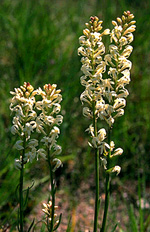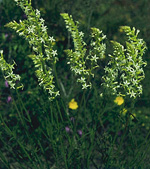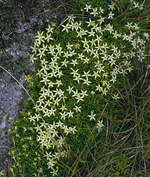 |
This family is almost entirely Australian, with only two species of Stackhousia occurring outside Australia (one in Malesia and Micronesia, the other in New Zealand). One or more species may be encountered almost anywhere in Australia, from alpine herbfields to the Central Australian deserts and the monsoonal tropics, always in open, grassy vegetation, usually on light-textured soils.
Characteristic features of the family Stackhousiaceae in Australia include:
- annual or rhizomatous perennial, erect, prostrate or cushion-forming
herbs, sometimes sub-shrubby, often with rather stiff, wiry stems and
relatively small, sparse leaves
- leaves alternate, usually narrowly obovate to linear, sometimes reduced
to scales
- flowers greenish, white or cream, usually in terminal racemes or spike-like
inflorescences
- sepals and petals 5, the latter free or united into a narrow tube
- stamens 5
- ovary superior but enclosed in a cup-shaped or tubular hypanthium
(superficially appearing inferior), developing into a fruit of 3–5
small, dry nutlets
Description
Annual, biennial or perennial herbs, or rarely evergreen shrubs. Leaves
rarely ±absent. Perennating by rhizomes, stolons or ?crowns. Vegetative
reproduction absent or by ?stolons. Stem internodes terete, or distinctly
angled, or winged. Internal secretions not obvious. Plants glabrous, or
with simple, non-glandular, uniseriate or multiseriate hairs. Leaves on
adult plant well developed, or rarely much reduced (i.e. to scales, etc),
alternate and spiral, all or mostly cauline, sessile, or rarely petiolate
or subsessile. Stipules apparently absent or present, free, bristle-like,
falling off early or persistent. Lamina simple, symmetric, linear, subulate,
ovate, lanceolate, elliptic, oblong, obovate or spathulate; base cuneate
or attenuate; margins entire, ±flat; venation one veined, rarely
pinnate, with the midrib conspicuous or inconspicuous, and the tertiary
venation absent; not punctate; herbaceous, rarely succulent; distinctive
odour absent. All the flowers bisexual. Inflorescences terminal or rarely
axillary, consisting of spikes, racemes, panicles, heads or solitary flowers,
or apparently umbels. Bracts present. Bracteoles absent or present. Pollination
by insects. Flowers odourless or fragrant, sessile or stalked. Free hypanthium
present or apparently absent. Floral disc absent or present; nectaries
absent or present on the disc or ?the anthers. Perianth of 2 dissimilar
whorls, imbricate in bud. Calyx regular; segments free or apparently fused,
with 5 sepals or lobes; calyx cup-shaped, bell-shaped or tubular, herbaceous,
leathery or succulent. Corolla regular, or rarely irregular; segments
free or fused, with 5 petals or lobes, alternating with the sepals or
calyx lobes; corolla salver-shaped, tubular, or rarely 2-lipped, white,
cream, yellow, orange, rarely pink, blue, green or brown, without contrasting
markings, membranous or succulent; claws absent or present; lobes ±entire.
Fertile stamens 5, opposite to the sepals or calyx lobes, free from each
other and from all other flower parts, ±equal, or unequal and then
alternating long and short. Anthers basifixed; not versatile, opening
inwards by longitudinal slits, 2-celled; appendages absent or apical.
Ovary superior and stalked, or apparently inferior. Carpels 3–5, fused;
ovary with 3–5 locules. Style terminal, single and branched above, with
the stigma clavate. Ovules 1 per locule; placentation basal. Fruit dry,
a schizocarp forming mericarps (cocci); the perianth on the maturing fruit
deciduous. Disseminule macro-surface featureless or with straight or hooked
hairs, bristles, spines or wings; micro-surface ±smooth, muricate,
tuberculate, rugose or verrucose, yellow, green, brown, without contrasting
markings, or conspicuously patterned, glossy or dull. Seeds 5 per
fruit. Embryo straight.
(Note: this description has been generated from the coded data compiled for the key. Any errors in the key data will be reflected in the descriptions.)
A treatment of the family Stackhousiaceae has been published in:
Flora of Australia 22: 186-199.
Australian genera of Stackhousiaceae (as recognised for the Flora of Australia)
Macgregoria
Stackhousia
Tripterococcus

|
  |

Macgregoria racemigera (flowering plant)
Photo: A.S.George © A.S.George

Stackhousia monogyna (flowers)
Photo: K.Thiele © K.Thiele

Stackhousia pubescens (flowers)
Photo: F.Humphreys © ANBG

Stackhousia pulvinaris (flowering plant)
Photo: C.Totterdell © ANBG

|
 |
|